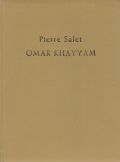Between tavern and madrassa: ‘Umar Khayyám the scientist. Bagheri, Mohammad.
In: The great ‘Umar Khayyám. Leiden, Leiden University Press, 2012. pp. 67-72.
This contribution focuses on Khayyám as a scientist and how his scientific merits are combined with his literary genius. Bagheri’s study includes Khayyám’s classification of cubic equations, his commentary on Euclid’s Elements, and Khayyám’s scientific achievements.

